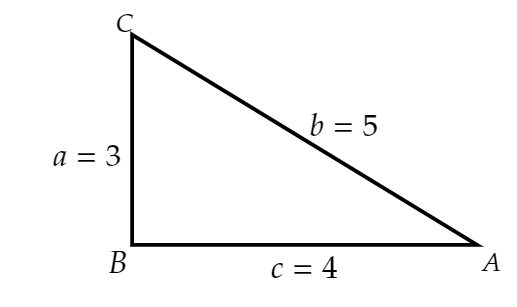
In \[\Delta ABC\], if the sides are \[a = 3,b = 5\] and \[c = 4\] then find the value of \[\sin \left( {\dfrac{B}{2}} \right) + \sin \left( {\dfrac{B}{2}} \right)\].
A. \[\sqrt 2 \]
B. \[\dfrac{{\sqrt {3 + 1} }}{2}\]
C. \[\dfrac{{\sqrt {3 - 1} }}{2}\]
D. \[1\]
Answer
218.1k+ views
Hint:
In the given question, we need to find the value of \[\sin \left( {\dfrac{B}{2}} \right) + \sin \left( {\dfrac{B}{2}} \right)\]. For this, we will use Pythagoras theorem to get the angle \[B\]. Using this angle \[B\] , we will get the desired result.
Formula used:
Let the sides of the right angled triangle \[ABC\] be \[a, b, and c\].
By pythagoras theorem: \[{b^2} = {a^2} + {c^2}\]
Complete step-by-step answer:
Consider the following figure.

Now, we will apply Pythagoras theorem in a triangle \[ABC\].
\[ \Rightarrow {b^2} = {a^2} + {c^2}\]
Given, \[a = 3,b = 5\] and \[c = 4\]
\[\Rightarrow {5^2} = {3^2} + {4^2}\]
\[\Rightarrow 25 = 9 + 16\]
\[\Rightarrow 25 = 25\]
Therefore, the triangle \[ABC\] is a right angled triangle at angle \[B\].
Thus, we get \[\angle B = {90^o}\].
Now, we will find the value of \[\sin \left( {\dfrac{B}{2}} \right) + \sin \left( {\dfrac{B}{2}} \right)\].
\[ \Rightarrow \sin \left( {\dfrac{B}{2}} \right) + \sin \left( {\dfrac{B}{2}} \right) = \sin \left( {\dfrac{{90}}{2}} \right) + \sin \left( {\dfrac{{90}}{2}} \right)\]
\[ \Rightarrow \sin \left( {\dfrac{B}{2}} \right) + \sin \left( {\dfrac{B}{2}} \right) = \sin \left( {45} \right) + \sin \left( {45} \right)\]
But \[\sin ({45^o}) = \dfrac{1}{{\sqrt 2 }}\] and \[\cos ({45^o}) = \dfrac{1}{{\sqrt 2 }}\]
\[\Rightarrow \sin \left( {\dfrac{B}{2}} \right) + \sin \left( {\dfrac{B}{2}} \right) = \dfrac{1}{{\sqrt 2 }} + \dfrac{1}{{\sqrt 2 }}\]
\[\Rightarrow \sin \left( {\dfrac{B}{2}} \right) + \sin \left( {\dfrac{B}{2}} \right) = \sqrt 2 \]
Hence, the value of \[\sin \left( {\dfrac{B}{2}} \right) + \sin \left( {\dfrac{B}{2}} \right)\] is \[\sqrt 2 \].
Therefore, the correct option is (A).
Note: Many students make mistakes in the calculation part as well as writing Pythagoras theorem. This is the way through which we can solve the example in the simplest way. Also, it is essential to get the correct value of \[\angle B\] to get the desired result.
In the given question, we need to find the value of \[\sin \left( {\dfrac{B}{2}} \right) + \sin \left( {\dfrac{B}{2}} \right)\]. For this, we will use Pythagoras theorem to get the angle \[B\]. Using this angle \[B\] , we will get the desired result.
Formula used:
Let the sides of the right angled triangle \[ABC\] be \[a, b, and c\].
By pythagoras theorem: \[{b^2} = {a^2} + {c^2}\]
Complete step-by-step answer:
Consider the following figure.

Now, we will apply Pythagoras theorem in a triangle \[ABC\].
\[ \Rightarrow {b^2} = {a^2} + {c^2}\]
Given, \[a = 3,b = 5\] and \[c = 4\]
\[\Rightarrow {5^2} = {3^2} + {4^2}\]
\[\Rightarrow 25 = 9 + 16\]
\[\Rightarrow 25 = 25\]
Therefore, the triangle \[ABC\] is a right angled triangle at angle \[B\].
Thus, we get \[\angle B = {90^o}\].
Now, we will find the value of \[\sin \left( {\dfrac{B}{2}} \right) + \sin \left( {\dfrac{B}{2}} \right)\].
\[ \Rightarrow \sin \left( {\dfrac{B}{2}} \right) + \sin \left( {\dfrac{B}{2}} \right) = \sin \left( {\dfrac{{90}}{2}} \right) + \sin \left( {\dfrac{{90}}{2}} \right)\]
\[ \Rightarrow \sin \left( {\dfrac{B}{2}} \right) + \sin \left( {\dfrac{B}{2}} \right) = \sin \left( {45} \right) + \sin \left( {45} \right)\]
But \[\sin ({45^o}) = \dfrac{1}{{\sqrt 2 }}\] and \[\cos ({45^o}) = \dfrac{1}{{\sqrt 2 }}\]
\[\Rightarrow \sin \left( {\dfrac{B}{2}} \right) + \sin \left( {\dfrac{B}{2}} \right) = \dfrac{1}{{\sqrt 2 }} + \dfrac{1}{{\sqrt 2 }}\]
\[\Rightarrow \sin \left( {\dfrac{B}{2}} \right) + \sin \left( {\dfrac{B}{2}} \right) = \sqrt 2 \]
Hence, the value of \[\sin \left( {\dfrac{B}{2}} \right) + \sin \left( {\dfrac{B}{2}} \right)\] is \[\sqrt 2 \].
Therefore, the correct option is (A).
Note: Many students make mistakes in the calculation part as well as writing Pythagoras theorem. This is the way through which we can solve the example in the simplest way. Also, it is essential to get the correct value of \[\angle B\] to get the desired result.
Recently Updated Pages
Arithmetic, Geometric & Harmonic Progressions Explained

Cartesian Form of Vector Explained: Formula, Examples & Uses

Apparent Frequency Explained: Formula, Uses & Examples

Calorimetry: Definition, Principles & Calculations

Centrifugal Force Explained: Definition, Formula & Examples

Charge in a Magnetic Field: Definition, Formula & Examples

Trending doubts
JEE Main 2026: Application Form Open, Exam Dates, Syllabus, Eligibility & Question Papers

Derivation of Equation of Trajectory Explained for Students

Hybridisation in Chemistry – Concept, Types & Applications

Understanding the Angle of Deviation in a Prism

Understanding Collisions: Types and Examples for Students

Understanding Atomic Structure for Beginners

Other Pages
JEE Advanced Marks vs Ranks 2025: Understanding Category-wise Qualifying Marks and Previous Year Cut-offs

How to Convert a Galvanometer into an Ammeter or Voltmeter

Ideal and Non-Ideal Solutions Explained for Class 12 Chemistry

Degree of Dissociation: Meaning, Formula, Calculation & Uses

Understanding Electromagnetic Waves and Their Importance

Understanding Average and RMS Value in Electrical Circuits




